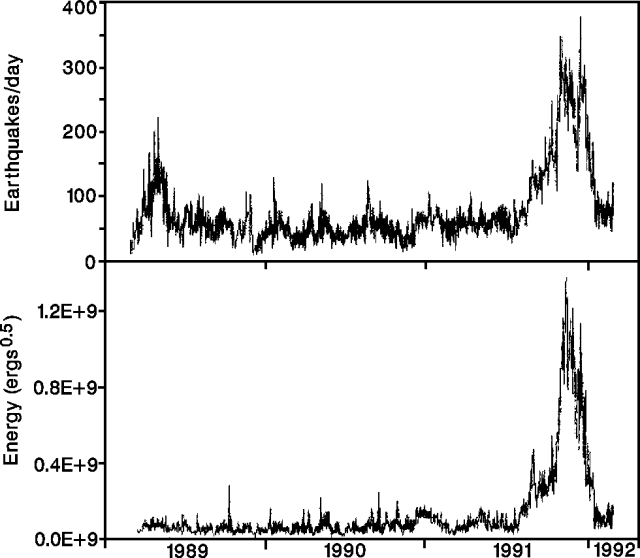Report on Galeras (Colombia) — January 1992
Bulletin of the Global Volcanism Network, vol. 17, no. 1 (January 1992)
Managing Editor: Lindsay McClelland.
Galeras (Colombia) Sporadic ash emission; seismicity down from October-November peak; no new dome growth
Please cite this report as:
Global Volcanism Program, 1992. Report on Galeras (Colombia) (McClelland, L., ed.). Bulletin of the Global Volcanism Network, 17:1. Smithsonian Institution. https://doi.org/10.5479/si.GVP.BGVN199201-351080
Galeras
Colombia
1.22°N, 77.37°W; summit elev. 4276 m
All times are local (unless otherwise noted)
Gas emission in January was punctuated by sporadic fine ash emission, a decrease from the intense degassing and almost continuous ash emission in September-November 1991. Sulfur accumulations were observed on the E edge of the October-November 1991 dome; no dome growth has been reported since mid-November 1991. The SO2 flux, measured by COSPEC, was at low levels.
Seismicity stablized in January, at levels somewhat higher than those recorded before the October-November 1991 peak in activity (figure 52). High-frequency earthquakes were centered around the active crater at 3.3-6.8 km depth. Long-period events, often associated with ash emissions, reached a maximum for the month on 20 January. Tremor was recorded as spasmodic pulses, most intense in the first half of the month.
 |
Figure 52. Daily number (top) and released energy (bottom) of earthquakes at Galeras, 27 February 1989-31 January 1992. Courtesy of INGEOMINAS. |
Electronic tilt measurements [at Crater Station] showed slight deflation in January (20 µrad, N component; no change, E component), ending a trend of inflation measured since September 1990. The rate of inflation increased rapidly in August 1991, then deformation stopped in November. Deformation [at Peladitos Station] fluctuated, but suggested slight inflation during the second half of the month (8 µrad in both components).
Geological Summary. Galeras, a stratovolcano with a large breached caldera located immediately west of the city of Pasto, is one of Colombia's most frequently active volcanoes. The dominantly andesitic complex has been active for more than 1 million years, and two major caldera collapse eruptions took place during the late Pleistocene. Long-term extensive hydrothermal alteration has contributed to large-scale edifice collapse on at least three occasions, producing debris avalanches that swept to the west and left a large open caldera inside which the modern cone has been constructed. Major explosive eruptions since the mid-Holocene have produced widespread tephra deposits and pyroclastic flows that swept all but the southern flanks. A central cone slightly lower than the caldera rim has been the site of numerous small-to-moderate eruptions since the time of the Spanish conquistadors.
Information Contacts: INGEOMINAS-Observatorio Vulcanológico del Sur.

